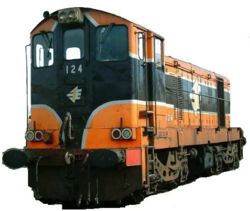CIE 121 Class
| Irish Rail Class 121 | |
 Iarnród Éireann No.124 The image above is a candidate for speedy deletion. It will be deleted on 2007-02-18. | |
| Also called: | Model GL8 |
|---|---|
| Builder: | General Motors, La Grange, Illinois, USA |
| Years Built: | 1960 |
| Number Built: | 15 Nos. 123, 124 and 134 survive |
| Replaced By: | Class 201 |
| Engine: | GM 8-567CR 126-129 Re-engined with EMD 8 cylinder B645E |
| Transmission: | 4 axle-hung nose-suspended EMD D47 traction motors, Series / Parallel Transition |
| Brakes: | Air and Vacuum |
| Length: | 39’10” |
| Weight: | 64 tons |
| Maximum Speed: | 77 mph (123 km/h) |
| Engine Horsepower: | Original - 875 hp 126-129 Re-engined- 1000 hp |
| Tractive Effort: | 709 hp 810hp re-engined |
| Operators: | CIE/IR |
The Iarnród Éireann 121 Class is a railway locomotive which was manufactured by EMD. These locomotives were in regular service on the Irish railway network until 2005.
History.
The Class 121 locomotives were manufactured in 1961 and numbered B121 to B135. As of 2007, two units still see occasional freight and passenger service. Prior to 1961, almost all Irish diesel locomotives were built in Great Britain, but from the 1960's onwards, GM became the sole supplier of locomotives to CIÉ, which eventually also extended to Northern Ireland Railways locomotives at a later stage. These were EMD's first ever fully American built loco's delivered to Europe.
The Class 121 locomotives were a typical American-style single cab ‘road switcher'. The layout of the cab was quite different to the other conventional CIÉ diesel models of the time, with the controls to the side of the driver, rather than the front. Due to apparent driver complaints of reduced visibility when operating with cab trailing, it was ultimately decided that these locomotives should only operate in a cab-leading formation. Later conversion for multiple-unit working allowed two 121 class locomotives to be coupled hood-end to hood-end, removing the need to turn them around for their return journey.
Although originally fitted with an EMD 8-567CR engine of 875 bhp, all were later fitted with 645 type "power packs" (piston & liner assemblies) for parts standardisation, while at the same time keeping their original power output for reliability reasons. They weighed 64 tons and had a maximum speed of 77 mph. Nos. 126-129 were later rebuilt with an EMD 8-645E engine of 1000 bhp; as used in the 181 Class locomotives.
All but three (121, 125, and 135) were fitted with Train Door Control equipment for operation with the Inchicore-built, BR Mark 3 based, Push-Pull train units. The push-pull equipment of locomotive No. 132 was subsequently decommissioned. Entering service in 1989, these trains, consisting of a single 121 Class and up to six carriages, were mainly used on the Dublin northern suburban passenger railway service. These were to be the last regular passenger duties for the 121s. In 1994, a railcar "revolution" had begun, and the push pull carriages were later re-deployed to inter-city duties with the Class 201 locomotives.
By 1995, the Class 201 had replaced the Class 121 on most passenger routes. Throughout the late 1990's the fleet dwindled, and by 2005 only Nos. 124 and 134 remained in service, with No. 123 in storage. The rest of the fleet has since been scrapped, due to the ongoing decline in freight traffic that they were also used for.
The last known passenger working of this class was the 13:15 Heuston-Waterford on 18/1/2007. Upon arrival in Waterford, they took the head of a delivery of new rails. Previously, they had filled in on the Manulla-Ballina service and some runs from Limerick. Their last scheduled mainline working was on Saturday, July 9th on the Sligo mainline.
Livery.
On delivery, the locomotives were painted in a Yellow and Grey livery. This was replaced within a year by a black / tan (“golden brown”) colour scheme with a thick white band similar to the Cravens coaching stock, delivered in 1963. With time, the colour scheme changed to tan with a black band. Soon after CIÉ Rail services became known as Irish Rail, the colour scheme was enhanced when two white bands (approx. 1" / 25mm) separating the colours were added. At the same time, as a safety aspect, red self-adhesive high-visibility panels were added to the front of the Locomotives.
See also
| Diesel Locomotives of Ireland |
| Republic of Ireland |
| 001, 071, 101, 113, 121, 141, 181, 201 (1st), 201 (2nd) |
| 301, 401, 421, 501, 601, 611, 801 |
| Northern Ireland |
| 1, 101, 104, 111, 208 |
